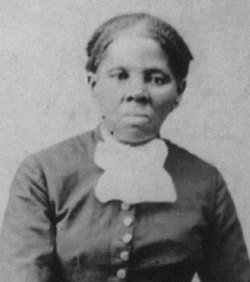Born Araminta Harriet Ross about 1820 on a Maryland plantation, Harriet witnessed the brutal treatment of and selling off and breaking up of many enslaved families, including her own.
In her young life, Harriet was beaten and abused, and bore lifelong physical and emotional scars. But the situation got worse. One day Harriet was in a store buying supplies, when another slave began to run away.
The overseer called to Harriet to grab that slave. When she refused and the slave got away, the irate man grabbed a two pound weight and slammed it into Harriet’s head, which she later said, “broke my skull.”
Unconscious and bleeding heavily, Harriet was brought back to her owner’s plantation, where with no medical care, she lay for two days. Now being “not worth a sixpence,” to her overseer, her owner tried to sell her, but without success because Harriet had become flawed.

Harriet Tubman
For the rest of her life, she would suffer seizures and headaches. But she also received powerful visions which as a devout Christian she attributed to God, visions which lead to the bold actions she would later take to rescue slaves.
In Harriet’s personal life, in 1844 at age 24, she married a free black man named John Tubman. But because she was a slave, any children they would have would belong to her owner. But the marriage ended childless in 1851.
Crying out for freedom, the first slave Harriet freed was herself. In 1849, at age 29, she risked her life and fled her owner’s Maryland plantation. After eluding the police and slave catchers, as well as facing hunger, exposure and other dangers, she arrived in Philadelphia.
Harriet could now claim to be free, that is unless the authorities in Philadelphia jailed her as a fugitive slave and returned her to Maryland authorities and back to her owner. But rather than flee farther north, Harriet began regular missions back to Maryland to free other slaves.
Using a network of abolition activists and safe houses called the Underground Railroad, Harriet led numerous slaves to safety, sometimes sending them as far north as Canada. But as a result, a huge bounty was placed on her life for she was wanted dead or alive.
Ever the courageous activist, in1861 when the U.S. Civil War began, Harriet worked for the Union Army, initially as a nurse, teacher and a cook, and later as a scout and a spy.
In 1863, she became the first woman to help lead an armed expedition, as she guided the Union Army Combahee River Raid, which freed more than 700 South Carolina slaves.
Meanwhile, Harriet had established her family home in Auburn, New York and for several months after the Civil War ended in 1865, she commuted hundreds of miles to Virginia to nurse injured soldiers, while also caring for her aging parents in Auburn.
But on one of those train trips to Auburn, tragedy struck. As a black woman, she was told by the conductor to move to the smoking car. Harriet refused and told him of her extensive government service. He grabbed her and when she clung to a railing, he called for help.
Harriet was thrown into the smoking car and severely injured. Yet because of all the commotion, some of the white passengers cursed her and called for her to be thrown off the train.
Then her situation grew worse.
During the Civil War, the Union never regularly paid Harriet and for many years thereafter, the U.S. government denied her a pension, claiming her service was difficult to document. Not until 34 years after the Civil War in 1899, when she 79 years old was Harriet finally granted a pension.
However, some of Harriet’s friends and admirers raised money to help support her. She became an advocate for women’s rights, while also devoting herself to the care of her family and to others in need, particularly former slaves.
To help make ends meet, Harriet opened her family home to boarders, and among them was a brick layer, a Civil War veteran named Nelson Davis. Although he was 22 years her junior, they fell in love and were married on March 18th, 1869 at the Central Presbyterian Church.
Five years later, they adopted a baby girl, Gertie, the only child Harriet would ever have.
Harriet’s marriage to Nelson Davis lasted for nearly 20 years, until his passing from tuberculosis in 1888. She remained active in women’s rights, including the right to vote until her health began to fail.
At the estimated age of 93, on March 10, 1913 in the company of family, friends and supporters, Harriet passed away from pneumonia.
But by then Harriet was widely known as “The Moses of Her People,” for having brought so many slaves to the promised land of freedom. Harriet had also captured the hearts and respect of many other people for her courage and compassion and for her ability to forgive.
Or in her words, “I am at peace with God and all mankind.”
And for having been invaluable to the Union Army during the Civil War, Harriet was buried with full military honors at Fort Hill Cemetery in Auburn. The keynote speaker at her service was one of the most famous African Americans in U.S. history, Dr. Booker T. Washington.
Today, her home, The Harriet Tubman Home is a National Landmark, administered by the AME Zion Church, and as a museum and education center, it welcomes visitors from all over the world.
